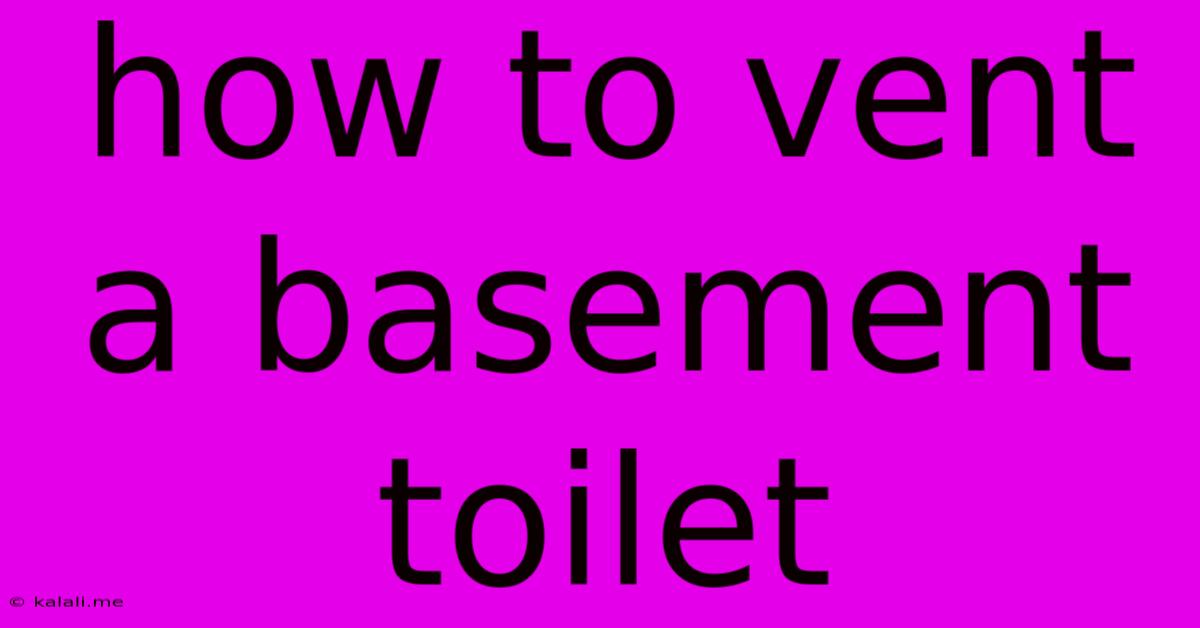How To Vent A Basement Toilet
Kalali
May 25, 2025 · 3 min read

Table of Contents
How to Vent a Basement Toilet: A Comprehensive Guide
Meta Description: Learn how to properly vent a basement toilet to prevent sewer gases, ensure proper flushing, and avoid costly plumbing issues. This comprehensive guide covers venting methods, code compliance, and troubleshooting tips.
Basement toilets often present unique venting challenges. Unlike upstairs fixtures, they require careful planning and execution to ensure proper functionality and prevent the backflow of sewer gases into your home. This guide will walk you through the process of venting a basement toilet, covering everything from understanding the basics to troubleshooting common problems. We'll focus on DIY-friendly methods and emphasize the importance of complying with local plumbing codes.
Understanding the Importance of Toilet Venting
A properly vented toilet is crucial for several reasons:
- Preventing Sewer Gas Backflow: Sewer gases contain harmful bacteria and unpleasant odors. A vent allows these gases to escape safely outside your home.
- Ensuring Proper Flushing: A vent equalizes air pressure within the drainage system. Without proper venting, the pressure differential can hinder the toilet's ability to flush effectively, leading to clogs and backups.
- Avoiding Plumbing Damage: Back pressure from a poorly vented system can damage your plumbing fixtures over time.
Methods for Venting a Basement Toilet
There are several methods for venting a basement toilet, depending on your existing plumbing setup and local building codes. Always check your local regulations before starting any plumbing work.
1. Connecting to an Existing Vent Stack:
This is the ideal scenario. If a vent stack is already present nearby, it's usually the easiest and most cost-effective solution. You'll need to connect a vent pipe from your toilet's drain to the existing stack, ensuring a proper slope and the correct pipe size. This often involves adding a tee fitting to the existing stack.
2. Adding a New Vent Stack:
If an existing vent stack isn't readily accessible, you'll need to install a new one. This involves running a vertical pipe from your basement toilet's drain up through the roof. This is a more complex project requiring careful planning and potentially professional assistance, especially if it involves drilling through floors and ceilings.
3. Using a Loop Vent:
A loop vent is a less common option, often used in situations where a vertical vent stack is impractical. It involves creating a loop of pipe that connects to the toilet's drain and rises above the flood level of the drain. This solution can be less efficient and might not be permitted by all local codes. Always consult local regulations before implementing this approach.
Essential Considerations for Proper Venting
- Pipe Size and Material: Use PVC pipes of the appropriate diameter as specified in your local plumbing code. PVC is a common and durable choice for venting.
- Pipe Slope: Maintain a consistent slope to prevent clogs and ensure proper drainage.
- Air Gaps: Ensure adequate air gaps to prevent siphoning.
- Proper Connections: Use appropriate fittings to create tight, leak-proof connections.
- Roof Termination: If installing a new vent stack, ensure the roof termination is properly sealed and weatherproof.
- Local Plumbing Codes: Always comply with local building codes and regulations. Improper venting can lead to significant penalties.
Troubleshooting Common Issues
- Slow Flushing: This could indicate inadequate venting or a clog in the drain line. Check for blockages and ensure proper venting.
- Sewer Gas Odors: This is a clear sign of a venting problem. Inspect the entire system for leaks and ensure proper connections.
- Gurgling Sounds: Gurgling noises during flushing indicate insufficient venting or a blockage. Investigate the drain and vent lines.
When to Call a Professional
While some simpler venting solutions can be DIY projects, installing a new vent stack or addressing complex plumbing issues is best left to experienced professionals. If you're unsure about any aspect of venting your basement toilet, consult a licensed plumber to ensure proper installation and code compliance. Preventing future problems and ensuring safe plumbing practices outweighs potential cost savings on a DIY project that might not meet code. Remember safety and code compliance are paramount.
Latest Posts
Latest Posts
-
How Many Cups Of Coffee In A Pound
May 26, 2025
-
How To Say Cat In Japanese
May 26, 2025
-
The Force Exerted By Point Charge
May 26, 2025
-
How To Sweap To Empty Hand Dark And Darker
May 26, 2025
-
Why Didnt The Ootp Tell Harry About Retrieving The Prophecy
May 26, 2025
Related Post
Thank you for visiting our website which covers about How To Vent A Basement Toilet . We hope the information provided has been useful to you. Feel free to contact us if you have any questions or need further assistance. See you next time and don't miss to bookmark.